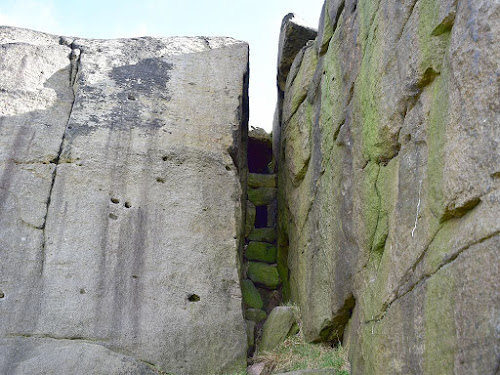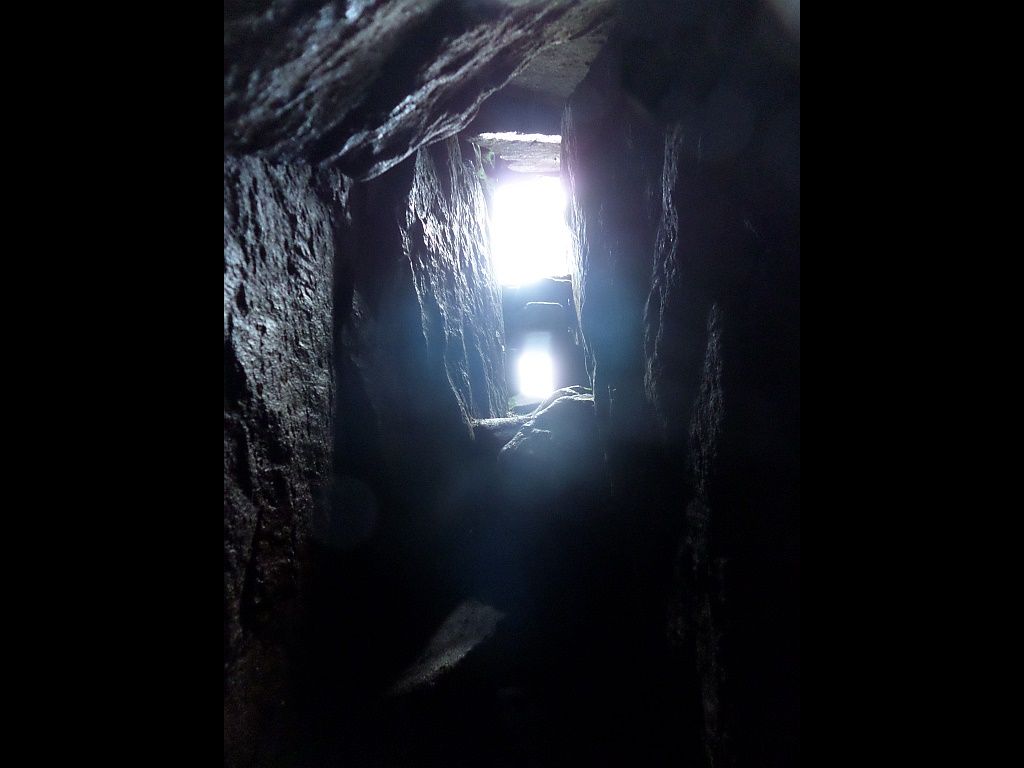Almscliffe Crag is a large rock outcrop located on a low hill, 4 miles to the south west of Harrogate.
The weathered mass of Millstone Grit sits at the southern end of a low ridge, elevating the crags into an even more prominent position, where they can be seen from many miles around. The top of the crags provide a 360° panoramic view, taking in the moors and surrounding farmland, and the valley of the river Wharfe to the south.
It is perhaps no surprise to find that such a notable landmark would feature in the areas folklore, and in this case the crags were believed to be home to the local faerie folk. It is worth noting that these were not the dainty winged creatures of Victorian imagination, rather they were believed to be supernatural beings, usually invisible to humans, but also able of assume any form when interacting with people. In the past there was a genuine fear of the faery race, as they were thought to be ever present, easily offended, and would cause death or bad luck to anyone who crossed them.
Ely Hargrove described Almscliffe Crags in the late 1700's .....
"Approaching these lofty turrets of Nature, they appear like so many castles tumbled into ruin, in the intervals of which are enormous blocks hanging in dreadful suspension.
On the west side of the rock, is a fissure called Fairy Parlour : this cavernous hole, which dips from north-west to nearly south-east, has been explored to a very great length, but where it ends is yet unknown. " (Hargrove, 1789)
Almost a century later, William Grainge also described the crags,
suggesting that they were once used for Druidical rites - a notion still
popular in his day.....
"Near the altar, towards the north - west, is the entrance to the “Fairy parlour”, a natural vertical joint or opening in the rocks, eighteen inches wide by five feet in height. It apparently dips with the strata in a south - easterly direction, and is said to have been explored to the distance of one hundred yards, and egress made at another opening ; other reports say that a goose turned into this fissure, followed the passage under ground, and came out near Harewood Bridge. Its name has always been associated with the fairy people, who were formerly believed to be all powerful on this hill, and exchanged their imps for the children of the farmers round about." (Grainge, 1871)
Folklore records that the fissure or passage leads to a cave beneath
the crags, with this chamber being the Fairies Parlour. The Reverend Thomas
Parkinson noted that ....
"It is to be doubted if any mortal has ever reached the fairy parlour. Some years ago, the story was related of daring explorers making the attempt, but so loud was the din, raised upon their advance, by rattling of pokers and shovels by the fairy inhabitants within, indignant at this invasion of the sanctity of their abode, that the too daring mortals precipitantly fled, by the way by which they had entered." (Parkinson, 1888)
Harry Speight adds .....
"At one point the fissure narrows, and is inaccessible, but standing up against it and listening, you may, it is said, hear a noise as of rocking, and the older country-folk around will tell you it is the fairies in their rocking-chairs whiling away the time!" (Speight, 1903)

|
|
OS Map (1851)
Map credit NLS |
The location of the entrance to the Fairies Parlour is not marked on any modern maps, however the first edition OS map (1851) does
show a 'Fairies Hole' alongside two circles marked on the west side of the
crags. It was assumed that this would be the Fairies Parlour, and that the
circles were perhaps cave symbols marking two entrances. A visit to the crags
some years ago found nothing where the western most circle was shown on the
map, while the second circle perhaps marked a walled up fissure in a part of
the outcrop known to climbers as the 'West Cave Group'.
More recently it was noted that the book Northern Caves Volume one (Brook, 1979) does list a cave at Almscliffe, and its location matches that described by William Grainge. This information places the entrance to the Fairies Parlour at the north end of the lower crag, or the 'low Man' as climbers call it. A Leeds school caving club explored this subterranean passage in the 1970's, when they had to crawl beneath 'poised blocks', negotiate narrow fissures, a 'violent dog leg' and a boulder choke, to finally reach an end chamber, 67 metres from the entrance. Not quite the 100 yards (or 3 miles to Harewood bridge!) mentioned by Grainge, however, any past movement in the rock strata may have closed off other passages. Sadly, there were no signs of faerie occupants in the end chamber, however a narrow fissure did lead on from it, so perhaps they still dwell further in beneath the crags, as noted by Harry Speight (see above).
A more recent account of the Fairies Parlour comes from Layla and Phil
Legard, and Simon Bradley, who produced an
E-book called 'Almias', as part of a
project for the 2010 Harrogate International Festival Fringe. As non cavers
they managed to explore the passage for 50m before it became increasingly
difficult/dangerous to continue. Their fascinating investigation into the
history and folklore of the crags is well worth reading.

|
|
Entrance to the Fairies Parlour |
A visit to the crags in 2020 located the entrance to the Fairies Parlour in a gap between the rocks on the north side of the Low Man outcrop (SE 26776 48960). The entrance to the tunnel has been partly walled up (apparently to stop foxes going to ground under the crags) but it is still accessible from above. Shining a torch into the passage revealed a narrow tunnel descending into the darkness, which did not look particularly inviting, but in the name of 'folklore investigation' it was decided to venture into the subterranean realm.

|
|
View from the entrance looking down the passage |
Access required an awkward wriggle down into the tunnel, which is
quite tight due its narrowness rather than a lack of height. A little way
along the passage there is a ledge, and here the floor level drops by over a
metre, but it is still possible to clamber down (and up!) this obstacle. On
the left side of the passage (after the drop) there is tall and narrow fissure
curving back up towards the surface, where it emerges at another opening amongst the
rocks, 10m north of the entrance. The main passage continues to drop down
beneath the 'poised blocks' mentioned in the caving guide, to a point where
the passage splits left and right. The guide describes either route as a tight
crawl to a very narrow fissure, or a fissure leading to a 'violent dog leg'.
It was at this point that the urge to investigate any further curiously
disappeared, and after taking some photographs, it was time to scramble back
out towards the light.

|
|
Further down the passage beneath the 'poised blocks' |
This tunnel has been part of the faerie folklore of the crags since at
least the late 1700's, and probably much earlier, but the origins of that folklore are now lost in the mists of time. Belief in the
supernatural began to decline rapidly during the 1800's, and the general fairy
folklore at that time seems to have become something of a melting pot -
merging beliefs in rock dwelling dwarfs (the original little people?), child
stealing fairies, and other more helpful spirits. Some isolated areas seem to
have preserved a little more of the separate identities of these beings, and
it is quite likely that if the crags had been located on the North York
Moors, then there would have been a Hob story attached to the cave (see
Hobthrush Hall). All these rock dwelling supernaturals possibly go back to a much older and
more widespread belief in healing spirits who were thought to actually live
within boulders, crags and rock faces. These 'healing rocks' and their locations were regarded as sacred, and gifts or offerings were left there by people seeking cures for illness. (For an example of the global scale of this
belief see the Native American "Makiawisug, or Little People".)
There still remains the puzzle of the 'Fairies Hole' marked on the
early OS map. Perhaps this referred to the two openings into the Fairies
Parlour, but they were somehow marked in the wrong place on the map? However, the
rocks in that area are called the 'West Cave Group', so the cave entrance at
that point may have also been thought to be used by the Almscliffe Faerie
folk.
The Faeries are just one element of the folklore connected with the crags, which also features the giant Rombald and his wife, the healing waters held in the rock basins, the lucky pins, and the odd goose in the tunnel story. The fragments of folklore which have come down to us, along with the impressive scale of the outcrop in the landscape, hint at this once being a key mythological site in the region, and well worth another post at some point.
References
Brook, D. (1979) Northern Caves (Vol 1) Wharfedale and Nidderdale.
Grainge, W. (1871) Harrogate and the Forest of Knaresborough.
Legard & Bradley (2010) http://almias.org.uk (PDF download)
Parkinson, T. (1888) Yorkshire Legends and Traditions: As Told by Her Ancient
Chroniclers.
Speight, H. (1903) Kirkby Overblow and District.
http://wyrduk.blogspot.com/2010/03/grey-stone-ring-carvings-harewood-and.html
https://www.mohegan.nsn.us/explore/heritage/our-stories/makiawisug








Excellent. Thank you. Pat O’Halloran
ReplyDelete